


GeoVISTA Studio: a geocomputational workbench
Mark Gahegan, Masahiro Takatsuka, Mike Wheeler and Frank Hardisty
GeoVISTA Center, Department of Geography, 302, Walker Building, The
Pennsylvania State University, University Park, PA 16802, USA.
Email: mark@geog.psu.edu URL:
http://www.geog.psu.edu/~geovista/
Abstract
One barrier to the uptake of Geocomputation is that, unlike GIS, it has
no system or toolbox that provides easy access to useful functionality.
This paper describes an experimental environment, GeoVISTA Studio,
that attempts to address this shortcoming. Studio is a Java-based,
visual programming environment that allows for the rapid, programming free
development of complex data exploration and knowledge construction applications
to support geographic analysis. It achieves this by leveraging advances
in geocomputation, software engineering, visualisation and machine learning.
At the time of writing, Studio contains full 3D rendering capability
and has the following functionality: interactive parallel coordinate plots,
visual classifier, sophisticated colour selection (including Munsell colour-space),
spreadsheet, statistics package, self-organising map (SOM) and learning
vector quantisation.
Through examples of Studio at work, this paper demonstrates the
roles that geocomputation and visualization can play throughout the scientific
cycle of knowledge creation, emphasising their supportive and mutually
beneficial relationship. A brief overview of the design of Studio
is also given. Results are presented to show practical benefits of a combined
visual and geocomputational approach to analysing and understanding complex
geospatial datasets.
Keywords: geocomputation, visualisation, knowledge discovery, classification,
inference.
1. Introduction
Geocomputation encompasses a wide range of different tools and techniques,
including data mining, knowledge construction, simulation and visualization,
all operating within the geographical realm. These activities take place
along the entire extent of the scientific process, often beginning with
abductive tasks such as hypothesis formation and knowledge construction,
through inductive tasks such as classification and learning from examples
and ending with deductive systems that build prescriptive models (that
are common in spatial analysis and GIS). However, unlike GIS, there is
no standard package or system that currently supplies these different types
of functionality as an integrated whole, instead users must resort to a
set of disparate (and often clumsy) programs that are difficult to connect
together operationally. This is a serious problem, and probably the biggest
barrier to the uptake of geocomputational methods currently.
Making such methods freely available and able to work in harmony is
a difficult task involving conceptual challenges associated with knowledge
construction as well as practical difficulties in a software engineering
sense. One possible solution is to build a software environment that can
hide some of the engineering, metadata and conceptual problems from the
user, whilst at the same time offering extensibility and the ability to
customise. GeoVISTA Studio is such an environment, offering programming-free
software development for a combination of geocomputation and geographic
visualization activities. Studio employs a visual programming interface,
allowing users to quickly assemble their own applications using a data-flow
paradigm from a library of functionality implemented as JavaBeans™
(JavaBean is a trademark of Sun Microsystems, Inc., 901 San
Antonio Road, Palo Alto, CA 94303 USA.)
After the following motivation section, the roles that geocomputation
and visualization can play throughout the scientific cycle are described
(Section 2), emphasising their supportive and mutually beneficial relationship.
Section 3 then examines some of the alternative methods by which knowledge
is constructed, and shows how they might be integrated conceptually. Following
this, an overview of the architecture of Studio is given. (Section
4). Example results from Studio are then presented in Section 5
to show practical benefits of a combined visual and geocomputational approach
to analysing and understanding complex geospatial datasets.
1.1 Reasons for building Studio
It is worth noting at the outset that building tools to support knowledge
construction and other geocomputational activities is not straightforward
because little is known yet about how these activities might be formalised
by a machine, or even how they might interact effectively. So, the building
of a geocomputational environment is at this stage somewhat speculative,
it is not possible to produce a design specification based on functionality,
as is common within the GIS industry. Bearing that in mind, the following
list of points acts as both motivating factors and design goals.
-
Humans engage in many different forms of reasoning (Section 3 takes this
up further) when tackling a scientific problem, yet current GIS address
only one explicitly, namely deduction, and provide only ad-hoc support
for others. New types of co-ordinated functionality are needed to generate
the categories, hypotheses, relationships and objects that GIS employ.
-
We do not know yet how best to support these knowledge and hypotheses construction
activities. By assembling together a range of learning, knowledge discovery
and visualisation tools in the same environment we can more easily investigate
the kinds of tools, linkages, controls and meta data that prove to be effective
in an operational setting. In doing so we hope to learn how to make this
kind of functionality interoperable in the future.
-
Stronger links between visualisation and geographical analysis are required.
GIS are getting better at visualising data, but are still largely tied
in to the cartographic paradigm, so lack the flexibility and functionality
required to support visualization targeted at knowledge construction. Furthermore,
some geographic simulation models are becoming so complex that it is imperative
to have visual means of tracking and steering their behaviour as they execute
(e.g. coupled atmosphere and ocean climate models, Hibbert et al.,
1996).
-
It is very difficult to exchange geographical models with other researchers.
Although standards for exchanging data are now quite advanced, we have
perhaps have lost sight of the fact that our data is only useful with appropriate
analytical models (Goodchild 2000), and do not yet know how to make these
interoperable. Studio provides both an environment in which complex
functionality can be linked together into models, and a simple method to
'wrap up' the assembled functionality into an application (a JavaBean)
that can be easily disseminated. Furthermore, using Bean technology, it
is straightforward to extend these models or couple them to additional
methods (Section 4 gives more detail).
-
By combining visual and geocomputational approaches within the same environment,
many benefits are realisable; three cases follow. Firstly, a visual interface
allows abductive knowledge discovery agents to report their findings within
a visual domain, thus drawing the expert's attention to potentially significant
patterns within highly multivariate data spaces. Secondly, inductive learning
agents can be trained in these visual data spaces from anomalies and structures
recognised by human experts. Thirdly, visualization allows the behaviour
of machine learning tools to be monitored during training or configuration
as a form of audit and control to ensure correct functioning (e.g. visualization
of hyperplane movement in neural networks). Section 5 provides some practical
examples.
1.2 Studio Capabilities
At the time of writing, Studio has the following functionality:
-
full 3D rendering capability including frame-by-frame animation, as is
available in Viz5D (Hibbert et al., 1996) but with the addition
of full control over all visual variables during 'playback';
-
interactive parallel coordinate plots, for dynamically visualising the
relationships between many attributes (Inselberg, 1997; Edsall, 1999);
-
a visual classifier, to convert continuous variables into mapable discrete
colour ranges (Slocum, 1999: Chapter 4), including manual and Jenks Optimal
methods (Jenks, 1977);
-
sophisticated colour selection, including RGB and Munsell colour-spaces
(Slocum, 1999: Chapter 5);
-
a spreadsheet, for keeping track of numerical values and for co-ordinating
data selection activities with other components;
-
a statistics package, to provide descriptive statistics on both samples
and populations, including some rudimentary spatial statistics and a range
of analysis and classification methods including: k-means clustering,
ISODATA and maximum likelihood (Dunteman, 1984);
-
self-organising map (SOM) and learning vector quantisation (LVQ) neural
networks (Kohonen, 1995) for classification, pattern analysis and machine
learning in complex feature spaces.
2. The Spectrum of Science
Our efforts to understand and model the world around us take many forms
(Mark et al., 1999). Even when a scientific perspective is specifically
adopted, there is no single universal standpoint or origin from which to
begin; the creation or uncovering of knowledge occurs at many levels and
starts in many places. What we see in GIS, for example, is often a well-ordered
world, comprised of discrete objects drawn from crisp categories, and associated
together with a small and precise set of logical relationships. Analysis
in GIS often starts with these objects, categories and relationships being
accepted as 'given', and proceeds to use them as part of some deterministic
model. The fact that GIS has proved itself to be beneficial in a number
of organisations and practical settings attests to the usefulness of these
starting assumptions. However, we do well to remember that they are assumptions,
nothing more. GIS are successful precisely because prior activities such
as fieldwork and data interpretation produced the objects, categories and
relationships used, from less abstract sources of information.
The idea, often implicit in GIS, that objects and categories have some
sort of 'natural' existence and order just waiting to be 'uncovered', is
a very old one, cropping up in the teachings of Aristotle. It has been
justifiably claimed that humans need categories to function (Lakoff, 1987)
and it appears that GIS do too! However, anyone who has worked with landcover
classification, geological mapping or eco-regions, for example, will well
understand the difficulty in creating classes in the first instance, not
to mention the problem of communicating them effectively to others. Conversely,
those who have needed to use such classes, but who did not play a part
in creating them, will be acutely aware of the frustration of never being
fully certain of what a class is supposed to represent. To make matters
worse, often the only clue to the true identity of a derived class is in
the name or label it is given and possibly a short description in an annotated
legend.
This description highlights a number of problems:
-
Constructing categories, objects and relationships requires different tools
to the ones available in GIS.
-
Geospatial information is often constructed in a different system to the
one within which it is applied, and increasingly not by the people who
will be the end users.
-
There is often a good deal of information loss when data are moved from
the system that created it to one that will apply it.
-
This lost detail may later be critical in understanding or correctly applying
some created object.
Geocomputation activities span this full range of knowledge construction,
and indeed are often associated with activities external to GIS because
they are creating information for a GIS to use.
3. Knowledge Construction
Focussing just on categories, this section describes different ways in
which categories can be formed, and some of the tools that might support
their construction. The structure and internal form of categories has long
been debated within philosophy and psychology (e.g. Peirce, 1891; Rosch,
1973; Baker, 1999) and has more recently received interest from the machine
learning community as algorithms are designed to automatically construct
and recognise (label) categories (e.g. Mitchell, 1997; Luger & Stubblefield,
1998; Sowa, 1999). This interest has stemmed from the real need to extract
information from large and complex datasets and reduce large data volumes
and complexities into some manageable form, for example by using data mining
or classification (Piatetsky-Shapiro et al., 1996; Koperski et
al., 1999; Landgrebe, 1999).
3.1 Defining categories
We now briefly address the issue of how categories might be defined in
order to understand better how computational methods might help. A number
of different mechanisms have been proposed by which a category might be
defined, based on cognitive studies of humans. A comprehensive overview
is given by MacEachren (1995: Chapter 4). The following are three of the
most obvious:
-
Typical examples, not necessarily real (e.g. Crocodile Dundee as a typical
Australian). Typical (but imaginary) examples are sometimes included in
map legends, in the interests of clarity.
-
Exemplars or best examples (e.g. Rock groups: the Beatles, the Stones).
These are defining examples that demonstrate the range or scope of a category,
and about which other members may cluster.
-
By some attributes or properties and their relationships (e.g. a hot day
is one where the temperature exceeds 25°
C). Most machine learning tools classify data using attributes only so
their categories are of this form.
The process of constructing a category in the absence of prior knowledge
is often associated with the inferential mode called abduction.
Taking some examples of a category and then producing a generalised description
that can be used, say for classification, uses an inductive mode
of inference. More on inferential mechanisms follows to help motivate the
need for new tools with which to perform geographical analysis. A full
description of inference in the earth sciences is given by Baker, 1999).
Deduction
A deductive tool behaves in a deterministic manner. It is not able to
adapt to the particularities of any given dataset so its outcome is defined
purely in terms of methods or rules that are pre-defined. Inductive and
abductive tools will produce different results if the dataset is changed
because they rely on the data to help structure the outcome (see below).
In the example above, defining a day as 'hot' if the temperature exceeds
25° C, is deductive. The category would
remain the same even if, in reality, most days have a temperature above
30° C. Deduction is most useful where a
system is clearly understood, as in category type 3 above.
Induction
With induction, characteristics in the specific data under consideration
help to shape the definition of a category. To continue with the above
example we might choose some sample days that we would term as 'hot' (i.e.
the concept of 'hot' is pre-defined by examples) and then construct a general
category from the attributes of the sample. In doing so we might find that
the concept of 'hot' varies with humidity as well as heat, or varies with
place (e.g. from the UK to Australia), or varies with time (from summer
to winter). Induction is very useful if the concept to be defined is complex,
the dataset is complex or we are uncertain how to define the concept deterministically,
but are confident in our ability to point to examples (category types 1
and 2 above). For precisely these reasons, inductively-based classifiers
are now becoming common in remote sensing applications, especially when
dealing with hyperspectral or multitemporal data (Benediktsson et al.,
1990; Foody et al., 1995; German & Gahegan, 1996). They may
well also become a crucial tool for understanding the large geospatial
databases now being created for socio-demographic and epidemiological applications,
simply because they are able to scale up to very large attribute spaces
more readily than conventional deductive approaches (Gahegan, 2000). Field
scientists often perform induction when they are presented with a number
of examples of some phenomena from which they must form a mental model
of a category, an example of the second way by which categories might be
defined given above.
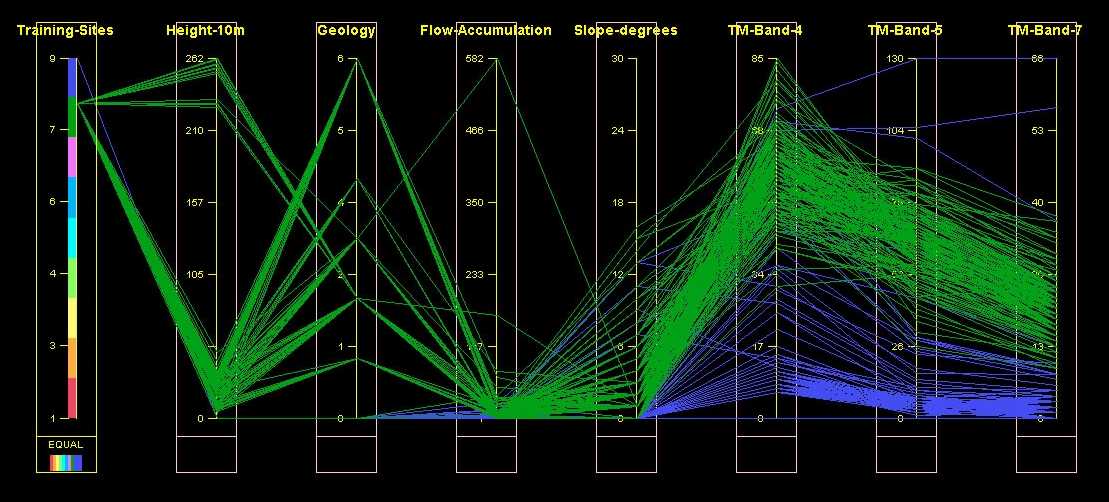
Figure 1. Visual analysis
of class separability using a Parallel Coordinate Plot. See text for details.
Figure 1 shows part of an inductive exercise. The categories in this case
have been imposed upon the data (the left-most axis) and two of them, water
(blue strings) and cleared land (green strings) are explored for potential
class separation problems with during classification. In this case the
two classes separate well on many of the available attributes, but note
the presence of some strange outliers, especially blue strings with very
high values for Landsat TM-Band-5 and TM-Band-7. These are likely to be
erroneous and should probably be removed prior to classification (see later).
Abduction
Abduction is the inferential mechanism used to generate categories in
the first place. In the Earth sciences, abduction is usually driven by
observations (data) and expertise working together. True abduction must
propose a categorisation and simultaneously give a hypothesis by which
the category can be recognised or defined. It is our own adeptness with
abductive reasoning that makes humans good Earth scientists. For example,
when a field geologist is logging an area, the categories to be used may
not be clear or fixed at the outset and new categories might need to be
created. Furthermore, simple labels are not the only outcome, the categorisation
produced has as its hypothesis an evolutionary geological model explaining
how each category might have come to be. Categories may be based on form,
structure, mechanical and chemical properties and reliance on any of these
properties may differ from category to category. They may well also reflect
the education, biases and experience of the geologist in question (see
Brodaric et al., also in this volume). In computational data mining,
unsupervised classification or clustering is often used to identify candidate
categories, with the algorithm that separates the classes (class definitions)
provided as the hypothesis. In contrast to the geology example, this is
perhaps a weaker form of abduction because the hypothesis produced only
relates to the attribute values in the data, and not to any additional
(externally held) knowledge.
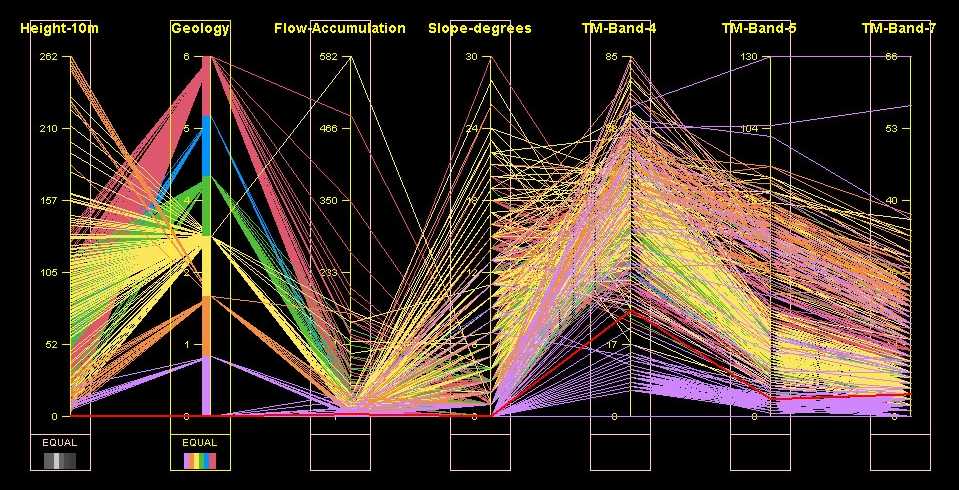
Figure
2. Using a parallel coordinate plot to search for possible classes in unstructured
data.
An example of the search for possible classes is shown in Figure 2. In
this example, the target landcover categories are undefined and the user
is exploring the clustering in the data that is characteristic of the 'Geology'
attribute. There appears to be some kind of partial relationship between
the remote sensing channels and this attribute, as evidenced by large swaths
of yellow and purple strings concentrating in the TM-Band-4 and TM-Band-5
axes.
3.2 Combining inferential tools and techniques
Having defined these generic types of inference, it should be clear that
geographers are in fact quite skilled in utilising all three, often in
combination and with no pre-defined methodological structure. That is to
say, there is no single mechanism by which these types of inference should
be combined; the task of building a 'system' for knowledge construction
is itself non-deterministic.
Figure 3 shows one possible arrangement for deriving categories from
data, involving iteration between abduction and induction. Visualisation
can play a key role in a number of these stages: in presenting a visual
overview of the data so that categories might be hypothesised, in evaluating
individual examples with respect to their 'representativeness', in portraying
the boundaries between categories (e.g. in feature space) and in showing
the results of applying the new knowledge to structure the data (Lee &
Ong, 1996; Keim & Kriegel, 1996; MacEachren et al., 1999).
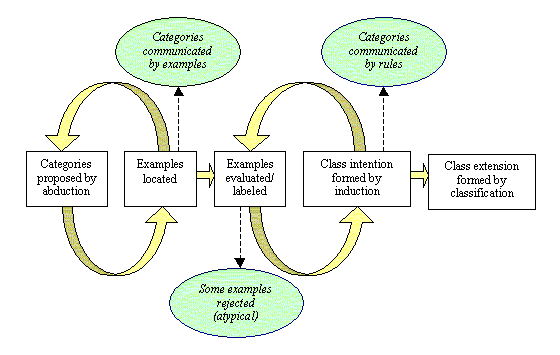
Figure
3. One possible scenario for the iterative construction of knowledge, involving
first abductive then inductive reasoning.
The results (Section 4) show examples of knowledge construction and
analysis using a variety of inferential tools and visualization methods,
working in combination.
4. The Design of
Studio
In order to carry out the sophisticated data analysis tasks outlined above,
a system has to bring together the various kinds of geocomputational tools
and techniques mentioned in Section 1.2. At its heart Studio has
a component-oriented software building system (called "builder")
that employs a visual programming environment to connect program components
together into useful applications (see Figure 4).
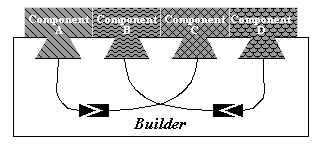
Figure
4. A builder constructs an application by connecting program components.
The builder allows different components, each offering pieces of
the required functionality, to communicate freely with each other. However,
the nature of these connections, i.e. what should be connected and how,
is not clear at the outset (as described in Section 3.2). Consequently,
the system needs also to provide an experimental environment to test and
discover how components should be connected to maximise the effectiveness
of constructing knowledge or otherwise analysing geographical data. To
meet these and other needs, the builder was designed to address
the following points: "Open Standards", "Cross Platform Support", and "Integration
and Scalability".
4.1 Open Standards
A builder has to accommodate components (tools) developed by different
parties. In order to handle this multi-developer problem, component design
must adhere to well-established standards. Studio employs Java as
the system programming language and so uses JavaBean technology to construct
tools. All visualization, geocomputation, machine leaning and other components
are implemented in the form of JavaBeans. The JavaBean specification defines
a set of standardised, component, Application Programming Interfaces (APIs)
for the Java platform. As long as a component is built according to this
specification, it can be incorporated into any JavaBean capable builders
as shown in Figure 5.

Figure
5. The builder integrates JavaBeans by using JavaBean APIs.
For the developers of components, this provides a straightforward mechanism
to ensure their components can be employed by many users (see Figure 6),
and is therefore extremely useful at increasing productivity in a postgraduate
laboratory setting! In other words, the end users can employ a wide variety
of JavaBean components developed by various suppliers. In using a JavaBean
component, a JavaBean capable builder automatically finds out a
syntactic description of its functionalities and input/output methods as
described below in Section 4.3.
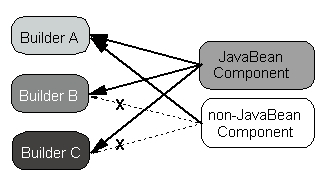
Figure
6. A JavaBean is accepted in any JavaBean capable Builders. A non-JavaBean
component is only usable in a propriety builder.
4.2 Cross Platform Support
Studio is designed to run on various operating systems (Solaris,
Windows, Linux, IRIX, etc.) and hardware architectures (Intel, SPARC, MIPS,
etc.). Since Studio itself is written in pure Java, Studio
and its JavaBean components will run on any operating system and hardware
combination as long as a Java Virtual Machine is available. (To check on
currently supported platforms, refer to http://java.sun.com/cgi-bin/java-ports.cgi.)
Moreover, Java's network capability allows a user to build network-aware
systems for heterogeneous hardware and operating system environments. For
instance, imagine a situation where two JavaBeans, A and B,
are processing a task together. If component B is carrying out a
computationally heavy task, a user might want to execute this component
on a more powerful machine. If both A and B implement network
functions, they can still communicate with each other as if they were executing
on the same machine (see Figure 7(a)). Even if both components do not have
network capabilities, a user can achieve the same result by connecting
them using network capable JavaBean components (see Figure 7(b)).
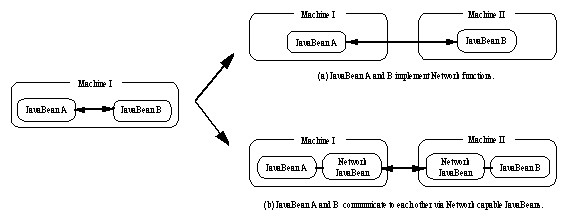
Figure
7. Using Java's network capability, JavaBeanson
different (hardware and software) platforms can seamlessly communicate.
4.3 Integration and Scalability
Studio, as a builder, must be able to integrate various kinds
of components from a multitude of sources. Studio provides a basic
set of JavaBean components, most of which are independently executable.
A user can combine these components to construct useful visualization,
geocomputational, and machine learning systems. However, solutions to a
specific problem might be difficult to build using only the pre-supplied
components; a user might wish to add in locally-produced components, or
might obtain components from some other source (Due to the popularity of
Java, there are many useful JavaBeans available already on the Internet).
In all cases, Studio has to provide a mechanism to integrate any
JavaBean component, regardless of its source.
In order to meet these requirements for a JavaBean capable builder,
Studio
utilises Java's introspection functions. With these functions,
Studio
is able to find out what kinds of input and output are available as well
as all the customisable properties of a bean when it is dynamically added
to Studio. A JavaBean sometimes supplies its own tool to customise
itself. Even in this case, Studio is able to incorporate this special
customising tool by using interfaces defined in the JavaBean specification.
With these features, Studio does not need any prior knowledge of
a new JavaBean in order to integrate it into a program developed under
Studio.
This is a clear advantage over older mechanisms involving recompilation
and linking, such as used in third generation computing languages.
Studio utilises Java's event model in order to let a user connect
JavaBean components together. When something of interest happens within
a JavaBean, the bean notifies other components by sending an event
object (like sending a message). When a user connects two JavaBeans with
a mouse dragging action an event adapter object, which is invisible to
a user, is created and is registered with an event source JavaBean as an
event listener object. When the event adapter detects that something interesting
happens it will call an appropriate method on the target JavaBean component.
Studio is also capable of 'wrapping' a whole connected graph
of JavaBean components into another single JavaBean. This allows a user
to gradually build up large scale and complex applications by constructing
from small and less complex components. Moreover, any JavaBeans constructed
at each stage of this gradual development can be shared or distributed
among colleagues since they are independent working program components.
5. Experiments using Studio
Two sample experiments are shown here, both aimed at investigating the
structure inherent in a large and complex dataset.
The first shows the co-ordinated application of: 1) a spreadsheet, showing
numerical values for individual data records; 2) an interactive Parallel
Coordinate Plot (PCP), depicting each record as a single 'string'; 3) a
Visual Classifier (VC), to interactively impose a categorisation on the
data; 4) an unsupervised k-means classifier. Using the Studio
environment described above these components are connected together as
shown in Figure 8. Other ancillary beans to read in and visualise data
also appear in the figure.
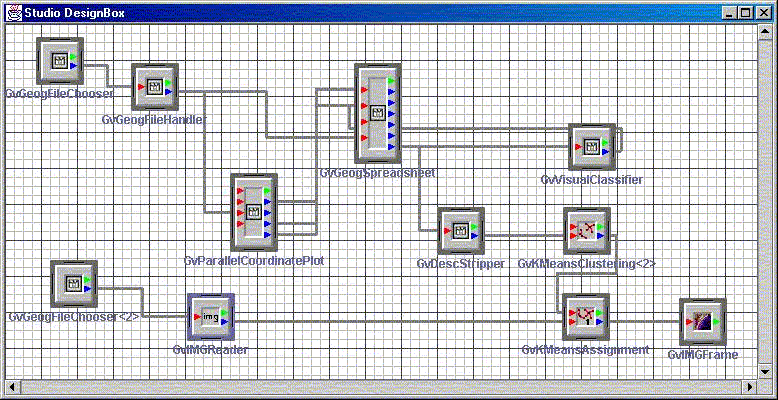
Figure 8. Design Box
from Studio showing components connected for data exploration leading
to classification. See text for details. Connections show the flow of data
and co-ordination of activities between the beans
The spreadsheet, PCP and VC can be used together to help explore an unfamiliar
dataset and lead to the configuration of a successful classification. The
PCP and spreadsheet allow the user to explore the data for outliers, errors
or missing values that can then be removed or corrected prior to classification,
since their inclusion will likely lead to problems. The VC and PCP allow
the user to experiment with different class structures by changing the
colours used for each of the strings, according to some chosen attribute
value. This helps the user to hypothesise structure or relationships within
the data (the beginnings of abduction) and also to select an appropriate
value for k, the number of classes to be used in classification.
To aid co-ordination, the components possess a degree of interaction. For
example, clicking on a string in the PCP will select the appropriate row
in the spreadsheet, and vice versa. Figure 9 shows an outlier in the PCP
(in red) that has been visually identified. Selecting it (with the pointing
device) automatically highlights the offending record in the spreadsheet
(Figure 10). It can then be deleted if required. Other selection behaviours
are also co-ordinated, for example selecting an axis in the PCP will highlight
a column in the spreadsheet, and change the focus of the VC, and so forth.
The selection of appropriate class breaks for visual display, using the
VC is shown in Figure 11. The data, minus any problematic examples that
are removed via the PCP or spreadsheet, are then passed to the k-means
classifier which then computes k centroids to represent data classes.
These centroids are then used to generalise to the entire dataset to form
the classified image shown in Figure 12, an inductive step. Without
removal of the problematic data, the final mapped result can be markedly
different to that shown.
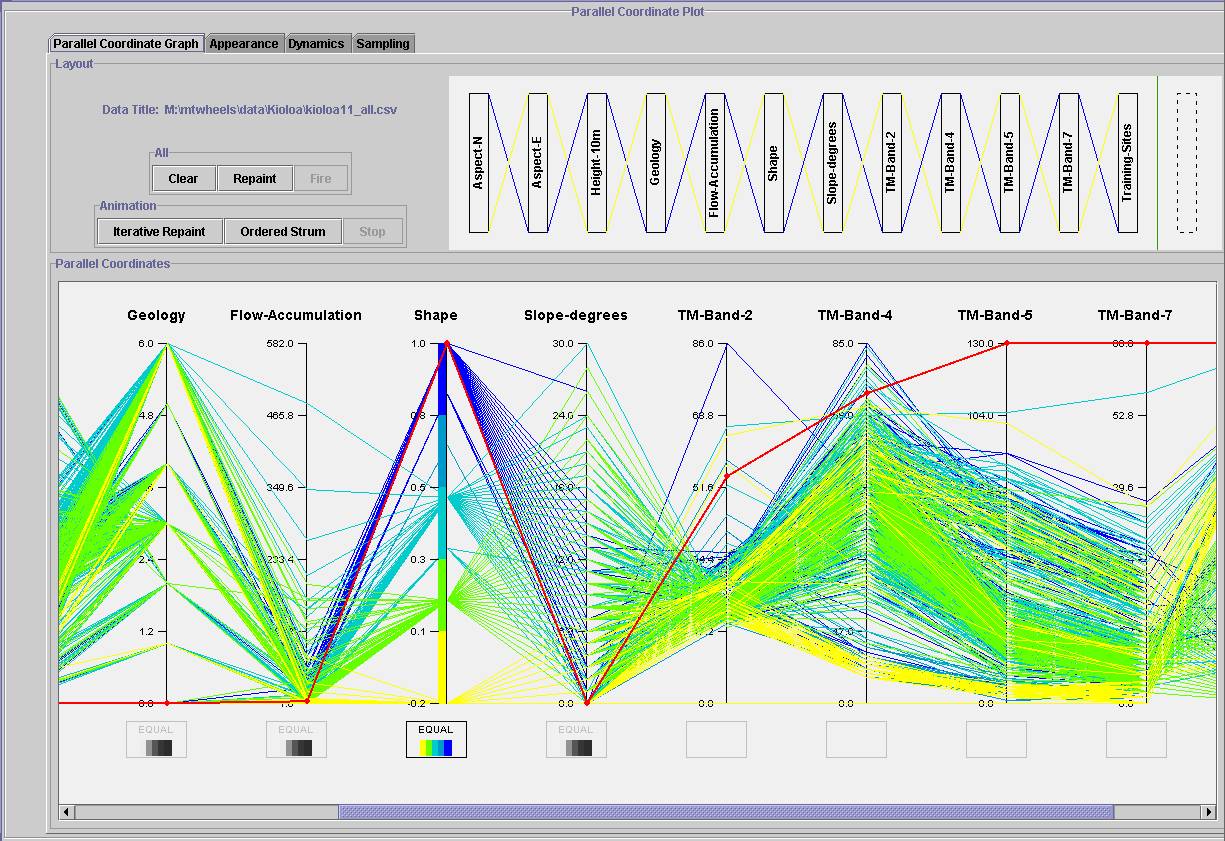 Figure
9. An interactive PCP used to study suitability of a training sample. An
outlier is shown in red, and this can be deleted if required. Strings are
grouped into five classes from a visual classification on the 'Shape' attribute.
Figure
9. An interactive PCP used to study suitability of a training sample. An
outlier is shown in red, and this can be deleted if required. Strings are
grouped into five classes from a visual classification on the 'Shape' attribute.
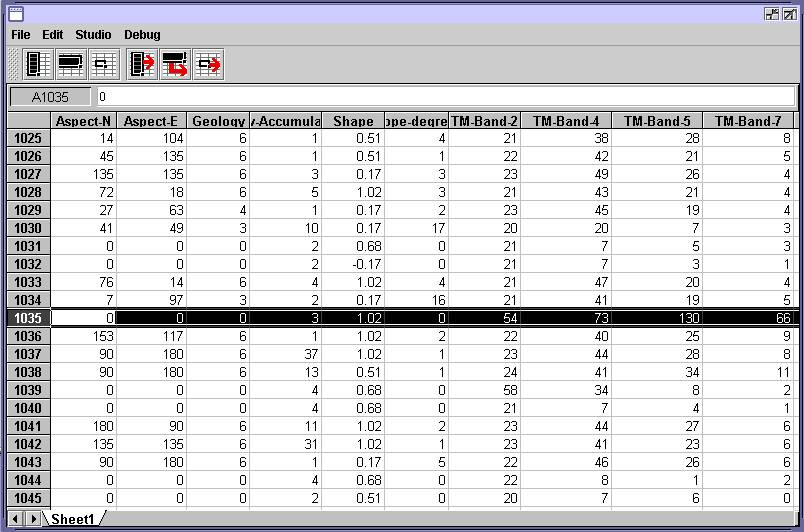
Figure 10. The spreadsheet, showing
part of the training data and automatically selecting the troublesome example
highlighted in the previous figure.
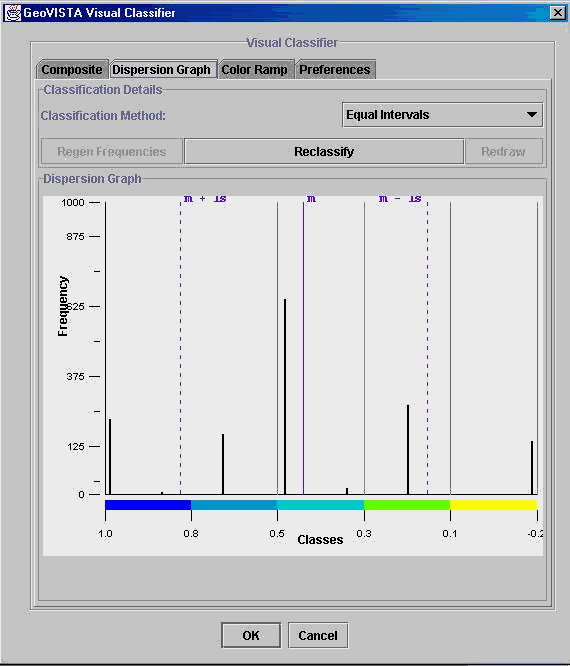
Figure
11. The Visual Classifier (VC) used to assign data ranges to the five colours
shown in the parallel Coordinate Plot above.
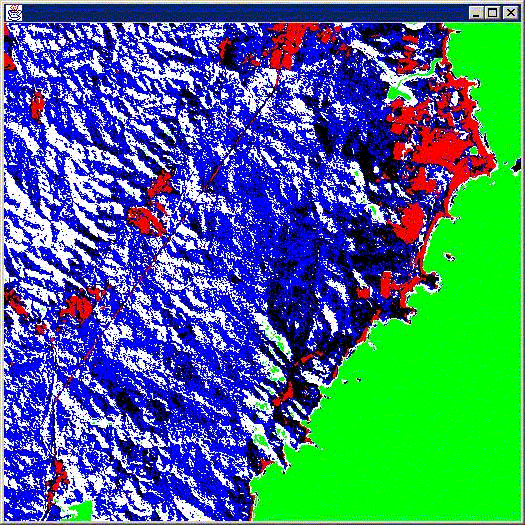
Figure 12. Results of
running a k-means classifier on the cleaned up dataset shown above.
The green class represents water, red is cleared land, blue, black and
white represent a mixture of forest vegetation types.
The components described above are shown, as they appear in Studio
operationally, in Figure 13.

Figure
13. A screen snapshot from Studio of the classification
exercise described above.
If a more sophisticated classifier is used, such as Kohonen's Self Organising
Map (Gahegan & Takatsuka, 1999), then one associated problem has been
the difficulty in understanding the inner workings of the classifier, thus
lowering our confidence in the outcome it produces and oftentimes leading
to exhaustive testing as a substitute. However, Studio allows us
to simply connect the state of the hidden layer of neurons at each timestep
(a 2D array of distance measures forming a surface) to the 3D renderer
so we can observe the classifier training in real time and ensure that
it does indeed converge to a reasonable solution. Figure 14 shows four
timesteps from the convergence of such a neural network and indicate a
stable progression towards the final outcome (a good sign).

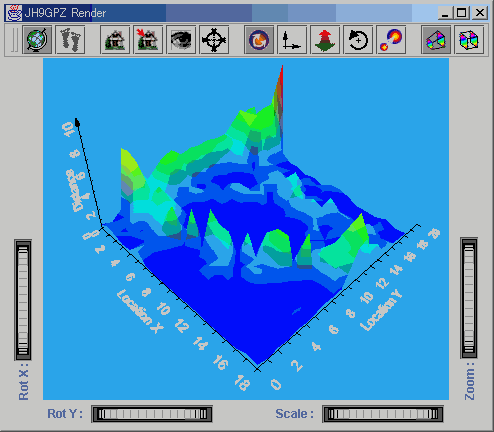
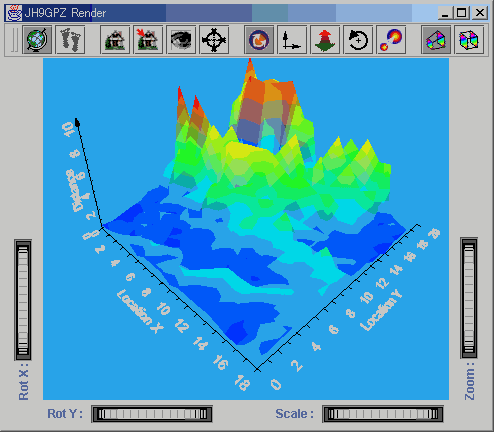

Figure
14. Images from the inside of the Self Organising Map. The 3D rendering
shows distance between neighbouring neurons in feature space. Distance
is normalised on the z axis from 0 - 10, with colour and height both visually
encoding this distance. The images show clean convergence of the network
at iterations 100 (top left), 300 (top right), 600 (bottom left) and 900
(bottom right).
The above applications were created without resource to conventional programming,
but instead by connecting together a series of independently created components.
These components form the backbone of Studio and obviously have
been designed to integrate effectively. However, other geocomputational
tools can be added into the mix with ease.
6. Conclusions and Future Work
With the continued development of advanced computational and visualisation
methods, coupled with a greater understanding of how these can be applied
to geographical problems and accompanied by breakthroughs in software engineering
we are entering an exciting era of new possibilities for geographical analysis.
Studio
represents one approach for taking advantage of these possibilities and
is a serious attempt to address the fundamental problems associated with
knowledge discovery, exploratory analysis, classification and object creation
as they relate to geography. It is perhaps too early to say whether the
design of Studio facilitates these tasks effectively, but our own
experience in developing the applications described above shows a promising
gain in efficiency over traditional programming methods, and a much greater
degree of integration and co-ordination among the component pieces, fostering
easier exploration and better understanding of both tools and data.
With the visual programming environment now completed, future Studio
development effort will focus on specific tools for geographic visualisation
and analysis. Our current plans include interactive scatterplots, Bayesian
knowledge discovery agents, and metadata (including semantic histories)
to allow us to study and communicate the formation of geographic objects
in greater detail. Further information about Studio, including sample
images and downloadable applications and data are available from http://www.geovista.psu.edu/studio/.
Future developments will also be posted to this site.
References
Baker, V. R. (1999). Geosemiosis. GSA Bulletin, May 1999, 111(5),
633-645.
Benediktsson, J. A., Swain, P. H. and Ersoy, O. K. (1990). Neural network
approaches versus statistical methods in classification of multisource
remote sensing data. IEEE Transactions on Geoscience and Remote Sensing,
28(4),
540-551.
Dunteman, G. H. (1984). Introduction to multivariate analysis.
Sage Publications, New York, USA.
Edsall, R. M (1999). The dynamic parallel coordinate plot: visualizing
multivariate geographic data. Proc. 19th International Cartographic
Association Conference, Ottawa, May 1999. URL: http://www.geog.psu.edu/~edsall/JSM99/paper.htm.
Foody, G. M., McCulloch, M. B. and Yates, W. B. (1995). Classification
of remotely sensed data by an artificial neural network: issues relating
to training data characteristics. Photogrammetric Engineering and Remote
Sensing, 61(4), 391-401.
Gahegan, M. (2000). On the application of inductive machine learning
tools to geographical analysis. Geographical Analysis, 32(2),
113-139.
Gahegan, M. and Takatsuka, M. (1999). Dataspaces as an organizational
concept for the neural classification of geographic datasets. Proc. Fourth
International Conference on GeoComputation, Virginia, USA: http://www.geovista.psu.edu/geocomp/geocomp99/Gc99/011/gc_011.htm
German, G. and Gahegan, M. (1996). Neural network architectures for
the classification of temporal image sequences. Computers and Geosciences,
22(9),
969-979.
Goodchild, M. F. (2000). Keynote address, Conference of the Association
of American Geographers, Pittsburgh, 2000.
Hibbard, W. L., Anderson, J., Foster, I., Paul, B. E., Jacob, R., Schafer,
C. and. Tyree, M. K. (1996). Exploring coupled atmosphere-ocean models
using Vis5D. International Journal of Supercomputing Applications and
High Performance Computing. 10(2/3), 211-222.
Inselberg, A. (1997). Multidimensional detective. Proc. IEEE conference
on Visualization (Visualization '97), Los Alamitos, CA: IEEE Computer
Society, pp. 100-107
Jenks, G. F. (1977). Optimal data classification for choropleth maps,
Occasional
paper No. 2. Lawrence, Kansas: University of Kansas, Department of
Geography.
Keim, D. and Kriegel, H.-P.(1996). Visualization techniques for mining
large databases: a comparison. IEEE Transactions on Knowledge and Data
Engineering (Special Issue on Data Mining),
Kohonen, T. (1995). Self-Organizing Maps. Springer-Verlag, Berlin,
Germany.
Koperski, K. Han, J. and Adhikary, J. (1999). Mining knowledge in geographic
data. Comm. ACM (to appear). URL: http://db.cs.sfu.ca/sections/publication/kdd/kdd.html.
Lakoff, G. (1987). Women, Fire and Dangerous Things: What Categories
Reveal about the Mind. Chicago: University of Chicago Press.
Landgrebe, D. (1999). Information extraction principles and methods
for multispectral and hyperspectral image data. In: Information Processing
for Remote Sensing (Ed. Chen, C. H.). River Edge, NJ, USA: World Scientific.
Lee, H. Y. and Ong, H. L. (1996). Visualization support for data mining.
IEEE
Expert Intelligent Systems and their Applications, 11(5), 69-75.
Luger, G. F. and Stubblefield, W. A (1998). Artificial Intelligence:
structures and strategies for complex problem solving. Reading, MA:
Addison-Wesley.
MacEachren, A. M. (1995) How Maps Work. Guilford Press, NY, USA.
MacEachren, A. M., Wachowitz, M., Edsall, R., Haug, D. and Masters,
R. (1999). Constructing knowledge from multivariate spatio-temporal data:
integrating geographical visualization with knowledge discovery in database
methods. International Journal of Geographic Information Science,
13(4),
311-334.
Mark, D. M., Freska, C., Hirtle, S. C., Lloyd, R. and Tversky, B. (1999).
Cognitive models of geographical space. International Journal of Geographic
Information Science, 13(8), 747-774.
Mitchell, T. M. (1997). Machine Learning, New York, USA, McGraw
Hill.
Peirce, C. S. (1891). The architecture of theories. The Monist,
1,
pp. 161-176
Piatetsky-Shapiro G., U. Fayyad & P. Smith (1996). From Data Mining
to Knowledge Discovery: An Overview. In: Advances in Knowledge Discovery
and Data Mining, (U. Fayyad, G. Piatetsky-Shapiro, P. Smith & R.
Uthurusamy, eds.), AAAI/MIT Press, pp. 1-35.
Rosch, E. (1973). Natural categories. Cognitive Psychology, 4,
328-350.
Slocum, T. A. (1999). Thematic Cartography and Visualization,
Prentice Hall: New Jersey.
Sowa, J. F. (1999). Knowledge Representation: Logical, Philosophical,
and Computational Foundations. Pacific Grove, CA: Brooks/Cole.

